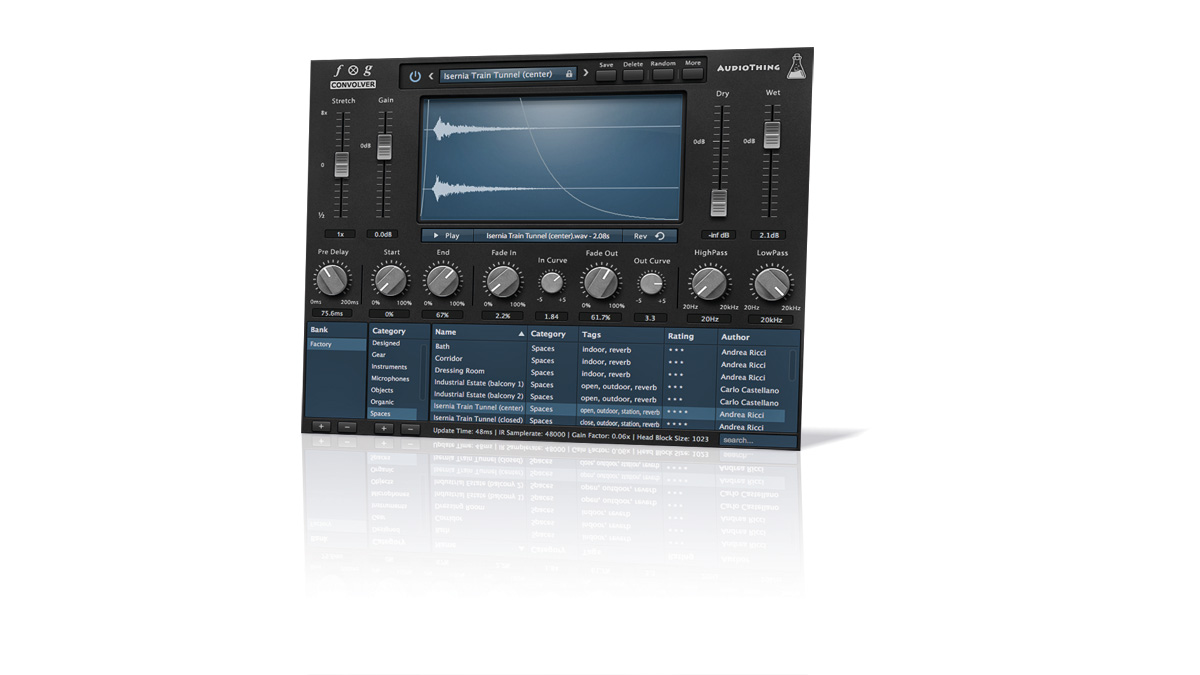MusicRadar Verdict
The lack of posh reverb IRs is a weakness, but for weird sound design and experimentation, Fog Convolver is a powerful plugin.
Pros
- +
Real-time waveform update. Good selection of unusual impulses. Export of modified IRs.
Cons
- -
Lacks regular reverb. IRs Audio drop-out during recalculation.
MusicRadar's got your back
The latest plugin (VST/AU/AAX) from boutique developer AudioThing, Fog Convolver is a convolution processor built on an impulse response engine and library with 254 presets and 254 IRs.
The interface is fairly self- explanatory, with adjustable parameters and a waveform display at the top, and the IR browser at the bottom. Controls include Pre Delay (0-200ms), IR Stretch (0.5-8x), HighPass and LowPass filters (20Hz to 20kHz for each), and separate sliders for input Gain, Dry level and Wet level.
The IR can be further shaped by editing Start and End points, and Fade In and Fade Out slopes with convex/concave Curve adjustment for each. Usefully, the central waveform display updates to indicate changes made by all parameters, including filters, Pre Delay, IR Stretch, and Fade In/Out, so you can see as well as hear all of your edits.
The Play button enables easy auditioning of the loaded IR, while over on the right, the Rev button reverses it. Meanwhile, the Settings page includes a 'Load IR only' option, letting you keep all your interface parameters intact while changing the impulse response. You can add further IRs in WAV format, and export edited IRs as WAV files.
With over 250 presets arranged across a number of categories, from Spaces and Microphones to Speakers and Gear, Fog Convolver covers plenty of ground.
In terms of reverbs, the emphasis is on lo-fi rather than high-end, with a number of IRs captured via TC Electronic's Fame pedal, some from Alesis' Quadraverb, and others from various spring reverbs, stompbox chains and quirky real-world spaces (hall, shed, tunnel, balcony and so on).
So, if you're after regular reverbs and classic reverb units, you'll need to source and import your own IRs.
Transform-a-sound
Fog Convolver also includes a number of IRs that you'd use to completely replace your source signal, such as speakers (radio, tape recorder, telephone, ear bud, etc), microphones (dynamic and telephone) and other devices (Type B Exciter and Multitrack Cassette Recorder, for example).
Finally, there are also some instrument samples (shakers, bongos and marimbas, to name but three) and a few synths, including both sequenced and one-shot sounds from an analogue modular.
The IR content is a mixed bag, and although we found some of the reverbs perfectly useable, and the stompbox chains good fun, hunting through the various folders for the effect you're after can be laborious.
Also, slightly frustratingly, pretty much all parameter changes, including the filters, result in the IR being re-calculated, which interrupts the audio output - albeit briefly and thus without a major impact on workflow.
Those niggles aside, Fog Convolver sounds excellent, is blessed with an impressively intuitive interface, and comes in at a very fair price. Potential buyers just need to be aware that it doesn't offer (or claim to offer) the usual convolution staple of high-end reverb - for that, you'll need to import your own IRs.
Computer Music magazine is the world’s best selling publication dedicated solely to making great music with your Mac or PC computer. Each issue it brings its lucky readers the best in cutting-edge tutorials, need-to-know, expert software reviews and even all the tools you actually need to make great music today, courtesy of our legendary CM Plugin Suite.
“The last thing Billy and I wanted to do was retread and say, ‘Hey, let’s do another Rebel Yell.’ We’ve already done that”: Guitar hero Steve Stevens lifts the lid on the new Billy Idol album
"This $399 item will incur over $578 in additional import charges": Price of Sonicware CyDrums drum machine more than doubles thanks to Trump tariffs
“For guitarists who crave an unrelenting, aggressive tone that stands out in any mix”: The Fortin Meshuggah head is the amp every metal player wants – now you can get its crushing tones in a pedal











